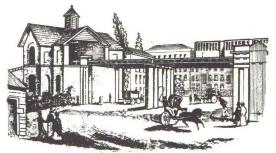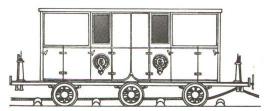London Blackwall
Fenchurch St NGR TQ335810 Blackwall NGR TQ384806
The London and Blackwall Railway began life as the Commercial Railway (Commercial Rd) but changed name when the line was allowed into Fenchurch St, it was more commonly known as the fourpenny rope due to its 4d fare.
Two steam winding engines at either end one by the Blackwall terminus and the other at Minories a short distance east of Fechurch St station were the power source of the railway they pulled a 7 mile long rope, 5.75" in diameter and ran on 5' gauge tracks. The railway was 3.5 miles long .
The building started with the two engine houses and the viaduct at the Minories end which carried the line 4000 yards until the West India dock embankment. It then passed into cutting into Blackwall. Before opening the company was granted permission to extend into Fenchurch St this was completed in 1841 and was not powered but used momentum to get into the station from Minories and gradient to get out again and reconnect to the rope, this section was completely enclosed. The line was opened in 1840 two years after starting construction, only one line was put in use and only three intermediate stations were open, Limehouse, West India Docks and Poplar. The second line opened a short while after as did the stations od Stepney and Shadwell. The trains were operated a a series of slip coaches which when approaching the station the back coach would detach itself from the set of coaches and the rope and glide to the intermediate station and remain there until the return journey when they would be collected by the main train back to the terminus. The lead carriage would collect the carriages at each intermediate station on their way to the terminus. This had the advantage of not requiring the rope to stop but the disadvantage that you could not travel between intermediate stations. The other disadvantage was that the 7 mile rope snapped easily, it was later replace by a metal cable. Half the rope was out on the line and traveled on rollers, the other half was on the two winding drums in the winding houses, they had to be manually guided onto the drums to avoid tangling. The carriages were 6 wheeled and between 18 and 20' in length and ornate for 1st class but more like cattle vans in second class. The railway was controlled by telegraph the first railway in the world to do so. The line was popular, and an extension was planned to Epping from Stepney and was to utilise another railway companies line which was standard gauge. From her on the line was doomed and was converted to standard gauge and the rope hauled railway ceased in 1849.

